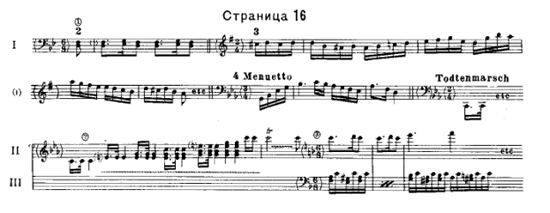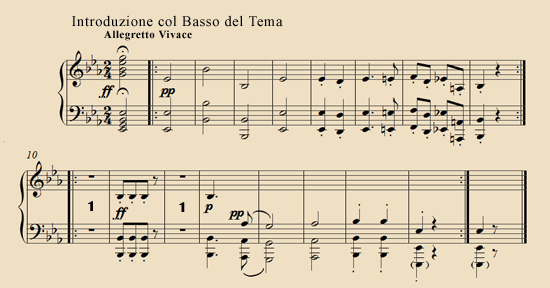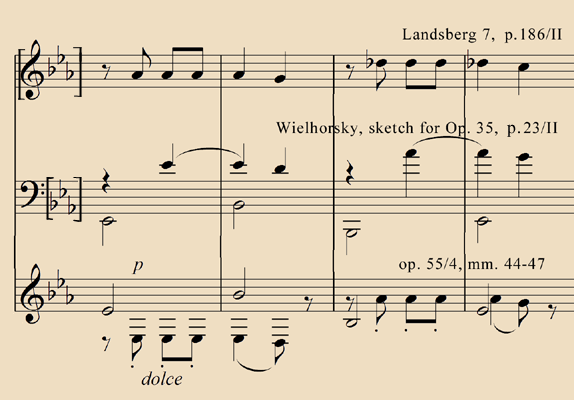Drafts for Op. 34 and Op. 35 appear in both the Kessler and the Wielhorsky sketchbooks, as noted earlier. Beethoven completed his sketching of the variations, and presumably began work on autograph scores, toward the end of his stay at Heiligenstadt in 1802. In describing them on October 18 of that year to his publishers Breitkopf & Härtel, he says that both cycles are written in an entirely “new manner”, and that the theme of each is “treated differently” from the other.112 The meaning of these remarks in relation to Op. 34 undoubtedly has to do with the fact that each variation is in a different key (descending by thirds) and meter; a more detailed analysis of the entire cycle, fascinating though it is, would take us too far astray. Here the concern is with the cycles only as they are related to the Eroica Symphony. Thus Op. 35 will be dealt with in toto, but of Op. 34 only the fifth variation—the Marcia (Allegretto, 2/4, in C minor)—will be considered, because it alone is directly related to the subsequent composition of Op. 55.
If we compare this fifth variation with the theme of Op. 34, the nature of this relationship will become more apparent. The harmonic plan of the theme (in F major) is followed fairly closely, if we allow for the change from major to minor mode, and its melodic outlines are also retained in a number of places, but its character has been completely transformed. The title, Marcia—Allegretto, seems hardly sufficient to describe the new mood. And in fact, if one turns to the sketches, he will find that Beethoven has written above the first draft of this variation the title “Todtenmarsch”, or “Funeral March”:

Fig. 19: Wielhorsky sketches for op. 34, on page 16, lines I-III (hereinafter: “16/I-III”) (transcribed by Nathan Fishman [Fishman, vol. II, at 19]).
The change in mood and character is so complete that Beethoven has written a special six-bar transition at the end of the variation in order to prepare for the return of F major in the sixth and concluding variation.
The striking similarity between the opening bars of this fifth variation and those of the second movement of the Eroica Symphony has been pointed out before, but in his edition of the Wielhorsky sketchbook, Fishman remarks that the similarity is nowhere so apparent as in the following early sketch (W16/XIII-XIV, and bars 1-4 of the Symphony’s second movement—from now on, written as “55/2, 1-4”):113
Wielhorsky sketchbook, 16/XIII-XIV


Fig. 20: Wielhorsky sketch for op. 34 compared to published version of op. 55/2
The sketches demonstrate that the fifth variation of op. 34 is the next link in the chain which begins with Prometheus’ death-music in the ninth number of the ballet, continues through the funeral march of the piano sonata Op. 26 to op. 34, and ends with the Marcia funebre of the Third Symphony. At no other time in his life was Beethoven so preoccupied with writing music for the death of a great hero than in these two and one-half years between the composition of Die Geschöpfe des Prometheus and the Eroica Symphony. It seems that the influence of the ballet music on subsequent works was not confined to the repeated use of a theme from its final number; concomitant to the legend of the hero’s rebirth is the hero’s death which must precede that rebirth. While this is not to suggest a programmatic content for all of Beethoven’s works with funeral marches in them, it does help to explain the proportionately large number of such pieces in his works of this period, compared to earlier and later periods—works in which the influence of the Prometheus “life-music” is generally quite manifest.
The companion piece to Op. 34 is Op. 35, which was begun a little earlier than the former work. It is here, of course, that one finds evidence of the Promethean influence; the Tema for the Variations Op. 35 is the rondo melody of the ballet’s finale, together with its bass. For the first time known to us, Beethoven in Op. 35 gives both melody and bass independent musical lives: each serves as a foundation for thematic development. The earliest sketches for op. 35, in the Kessler sketchbook, show that Beethoven realized the potential of developing the bass as a separate theme almost from the very first.114 This feature by itself makes the Op. 35 cycle “variations [written] in a new manner”, and also differentiates the cycle from Op. 34.
Op. 35 differs also in its unusual introduction—not only does Beethoven break out the bass as its own theme, but he begins the entire work with it:

Fig. 21: Prometheus-variations, op. 35 (Introduction)
Such a startling idea, which sets the stage for the full Tema only after the bass has been enveloped in counterpoint A due, A tre and A quattro, was entirely new for its time. As the reader is aware, Beethoven uses the same scheme in opening the finale of the Eroica Symphony. Fishman, followed by Maruyama and Cooper,115 sees the explanation of this development as a summation (in highly condensed form) of the Prometheus scenario: the opening chord of Op. 35 depicts the life-giving touch of the heavenly fire (in Op. 55/4, the chords are preceded by the storm and raging of Zeus), and the pianissimo octaves of the bass are the creatures’ subsequent first tentative steps. As they develop and progress to higher stages of awareness, the Basso del Tema moves to higher and higher registers and the counterpoint becomes successively more intricate. Finally the pinnacle of the process is reached as the theme itself is born from a previously established harmony.
It is a picturesque explanation, and perhaps not without some foundation. It is entirely possible that Beethoven liked the idea of developing the Basso del Tema separately at the beginning of the work because, when he played it (or heard it in his head), it called to mind his original music for the creatures; when the bass is stated piano (or pizzicato, as in the Symphony finale), it has the same character of tentativeness and incompleteness.116 The listener knows at once that this is not all there is to come. But it is in this feeling of expectation, rather than in any intended synopsis of the ballet action, that Beethoven’s procedure would seem to lie. By the time the Eroica Symphony was first performed publicly in 1805, no one had seen the Prometheus ballet for nearly three years, and as mentioned earlier, by the time the ballet music—other than the Overture—was first performed again in 1843, the ballet scenario had become lost (if it ever existed in the first place).117 Thus it would have been a rare member of the public who could have appreciated Beethoven’s intent to summarize in his introductory music the action of the ballet. (Indeed, the critic who wrote the long analysis of the Eroica for the Allgemeine musikalische Zeitung—one who might be expected to grasp any such intent on Beethoven’s part—instead took Beethoven’s music literally.118 He analyzed the bass theme as the principal motif of the finale, and treated the Prometheus-melody itself as just counterpoint!) On balance, therefore, it seems best to say that the Introduction is precisely what its name implies—it prepares what is to follow. Beethoven hit upon the inspired idea of using the bass alone for this purpose, and the result is a new facet added to the familiar variation form.
The details of how he came to use the bass as a theme in its own right are disclosed, as far as one may discern, in the Kessler sketchbook, and have already been described in an article by Christopher Reynolds which fully analyzes all the Kessler and Wielhorsky sketches for Op. 35.119 Beethoven appears first to have entertained the idea of beginning the work with the bass line stated in half-notes, in 2/4 meter (he has crossed these measures out in the original, but he retained the idea in the final version):

Fig. 22a: First sketch of Basso del Tema in the Kessler sketchbook
In his next sketches, he starts to experiment with how the bass (still stated in half notes) can be developed fugally:


Fig. 22b: Subsequent development of the Basso del Tema in Kessler
It was only later that he hit upon the “introductory” character of this theme when stated piano and staccato. But that is entirely typical of the process by which Beethoven would thoroughly develop and examine all the latent potentialities in any given theme. If the piano version was also partly occasioned by a memory of his music for the creatures’ first movements in the ballet, who is to say that the coincidence was not a happy one?
The process of the working out of the subsequent variations and fugue of Op. 35 is well documented in the sketchbooks, and Christopher Reynolds has analyzed how Beethoven assembled the piece from its component parts (Reynolds 1982). None of that need be repeated here; instead, we will concentrate on the connections to be found between Beethoven’s work on Op. 35 and his subsequent composition of the Eroica. This is not to treat Op. 35 as some sort of preliminary exercise for the composition of the Third Symphony; as Fishman notes in his commentary on the sketches: “No matter how glittering the shine of the Eroica, one cannot ignore that its closest satellite radiates not only a reflected light, but its own as well.”120
The parallels between the published versions of the Third Symphony and Op. 35 have also been treated elsewhere.121 While the Symphony finale follows fairly closely the Introduction of the Variations Op. 35 as far as the former’s 108th bar, the development of the Prometheus-theme unfolds very differently in the Symphony after that, and any comparisons between the two works become forced.
The point instead is to note that Beethoven sketched and composed far more music for the variations than he eventually included in the published opus.122 It is Fishman’s contribution to show how the Symphony benefited from this fecundity, and he gives numerous examples of ideas that were conceived in the course of sketching the Variations but were not included in the published work, and which were instead conserved for use in the Symphony finale.123 For example, among the sketches for the finale of the Variations is found the following draft on page 32 of Wielhorsky, at line V—it is for an accompaniment to the fugue theme which was not used in the published version, but which appears instead in bars 227-30 and 235-38 of the Symphony finale (reproduced on the second staff):124

Fig. 23: Wielhorsky sketchbook (32/V) compared with Eroica finale, mm. 227-30; 235-38
Again, on page 27 of Wielhorsky is a draft for the middle section of the fifth variation of op. 35, a draft which is entirely different from that which Beethoven finally decided upon. But Fishman compares it with the well-known oboe melody from the Poco andante of the Eroica finale (beginning at bar 365):125
 Fig. 24: Wielhorsky sketchbook (27/IV) compared with Poco andante from op. 55/4
Fig. 24: Wielhorsky sketchbook (27/IV) compared with Poco andante from op. 55/4
As a final example of the continuity that runs from the ballet to the Symphony, Fishman cites a sketch from the last page of Landsberg No. 7 (see Fig. 25 below).126 At the time Beethoven wrote it, Fishman believes he was considering using it in the tragic scene in No. 9. (Based on the material surrounding it, Mikulicz assigns it—somewhat incongruously, in my opinion—to the first number.) The idea surfaced again as Beethoven was working on the final sketches of the finale to Op. 35, and Beethoven once more rejected it in the finished score—only to resurrect it as what is now the well-known countersubject in the early bars (44-47) of the Eroica’s finale:

Fig. 25: Countersubject considered and rejected twice (1801 and 1802) by Beethoven before its incorporation into the Eroica finale, in 1803
Given that his initial sketches for a third symphony immediately follow this profligacy, one can only conclude that the sheer compositional abundance to which the Prometheus-theme inspired Beethoven must have, as part of the same process, given rise to the idea of embodying that same music in a work where it could receive fuller expression—a symphony. And given the nature of the Prometheus-music itself, and what it signified to Beethoven (as discussed earlier), there can be no doubt that Beethoven’s choice of that music as a subject for his symphonic work evinced his determination, after the crisis at Heiligenstadt, to show virtue in the face of undeserved adversity, and to let its triumph—as he had already experienced it in completing the op. 35 variations—be given full expression in a major new symphony.
ENDNOTES
112 BGA, No. 108.113 Fishman, vol. III, at 65.
114 See the Kessler sketchbook (Brandenburg [ed.] 1978), beginning with the octaves in half notes on page 83r; Reynolds 1982, at 50ff.
115 Fishman, vol. III, 66; Maruyama 1987, at 79-80; Cooper 2000a, at 133; see also Schleuning and Geck 1989, at 112-15, 151-61.
116 It should be borne in mind, however, that Beethoven’s first sketches of the bass theme separately are given as half notes, in 2/4 time—see Fig. 22a/b in the following paragraph.
117 Sonnleithner 1861; see discussion supra in the section The Ballet..
118 “Review”, Allgemeine musikalische Zeitung 9 (February 18, 1807), 321-33; Eng. tr. in: Senner, Wallace and Meredith (eds.) 2001, No. 149, 20-32, at 26f.
119 Reynolds 1982; see his Table 1, at p. 51.
120 Fishman, vol. III, 83.
121 In Mies 1953-54, at 97ff; Schenker 1930, 75; Fischer 1949; Lockwood 1991; Gleich 1996.
122 The details are given in Appendix II to Reynolds 1982.
123 Fishman also shows how Beethoven used ideas from his sketches for op. 35 in still other works, such as in the Piano Sonata Op. 31, No. 3 (Fishman, vol. III, 147-48).
124 Fishman, vol. III, 77.
125 Fishman, vol. III, 76.
126 Fishman, vol. III, 78.